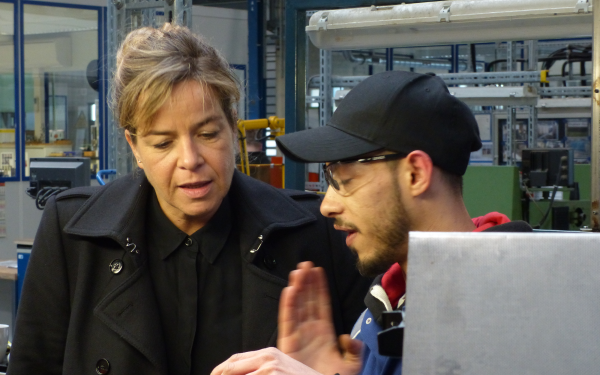Mona Neubaur, Minister for Economic Affairs, Industry, Climate Protection and Energy and Deputy Minister President of North Rhine-Westphalia, met with company representatives at the Outokumpu plant in Krefeld.
The entire steel sector is facing the enormous challenge of becoming more sustainable and making the production processes of the future climate-neutral. With a carbon footprint that is already 70 percent lower than the global industry average, Outokumpu is leading the way towards greater sustainability and climate protection and has set itself ambitious targets.
As early as 2021, the company has committed to the 1.5 degree climate target of the Science Based Targets Initiative (SBTi). This means it remains the only stainless steel manufacturer to have committed to these ambitious CO2 reductions. And certification procedures to ResponsibleSteel standards are currently underway for all European production sites.
New Circle Green product line
With the launch of the new Circle Green product line, Outokumpu has set another milestone in sustainability. With Circle Green, complete CO2 emissions (Scopes 1, 2 and 3) have been reduced by around 90 percent compared to the global industry average. This means that customers save more than 5 tons of CO2 per ton of stainless steel with this product compared to the global industry average of around 6.1 tons of CO2 emissions per ton of stainless steel.
For the corresponding transparency, Outokumpu provides its customers with so-called Product Carbon Footprints (PCF) for all of the company’s products. These are product-specific information on total emissions along the production chain, which include Scope 1, 2 and 3 emissions and do not include any climate offsetting.
Sustainability not an end in itself
“We can look back on a strong track record in sustainability. With Circle Green we are now setting completely new standards for sustainable stainless steel and can demonstrate how environmentally friendly stainless steel can already be produced today,” says Stefan Erdmann, Chief Technology Officer & Group Sustainability. “But sustainability is not just an end in itself for us. Our development efforts directly benefit our customers in that the lowest possible CO2 emissions ultimately also improve their carbon footprint through reduced emissions from the upstream supply chain, making our customers’ products more sustainable.”
Mona Neubaur, Minister for Economic Affairs, Industry, Climate Protection and Energy of the State of North Rhine-Westphalia:
“In order to secure industry in North Rhine-Westphalia in the long term and continue our state’s success story, we need strategies for decarbonization and resource efficiency. As the state government, we are supporting energy-intensive companies with precisely tailored funding instruments and offers of assistance to master the major challenges of climate-neutral transformation. I am therefore very pleased that Outokumpu here in Krefeld is making massive CO2 savings in steel production with the Product Carbon Footprint. This shows how the transformation of our industry can succeed.”
Implementation of a biocoke plant underreview
Sustainability plays a major role at the Outokumpu plant in Krefeld. Here, Circle Green material produced in Tornio, Finland, is further processed according to customer specifications. Investments totaling around 7 million euros are planned for various energy efficiency projects. These investments are intended to help further optimize the already efficient processes. This is because Outokumpu has set itself the goal of increasing energy efficiency by a total of 8 percent in 2023 and 2024. The aim is to significantly reduce the consumption of resources per ton of stainless steel produced. In addition, Outokumpu is currently examining the feasibility of a biocoke plant that can be used to generate gas from waste wood.
“We regularly examine all options for making our production even more sustainable,” says Dr. Cem Kurutas, managing director and head of the Krefeld plant. “This applies to the recovery of heat from our production processes as well as to measures with which we can save resources and promote biodiversity at our sites.”
Neue Metallpulverzerstäubungsanlage
Um Letztere zu unterstützen, wird es die „Bienenwiesen“, die vor einigen Jahren im Dillenburger Outokumpu Werk erfolgreich angelegt wurden, bald auch in Krefeld geben. Kurz vor dem Produktionsstart steht die neue Anlage für die Herstellung von hochwertigem Edelstahlpulver für die Additive Fertigung. Diese wurde in Zusammenarbeit mit der SMS group in Krefeld aufgebaut. Diese Metallpulverzerstäubungsanlage wandelt Edelstahlschrott in hochwertiges Pulver um. Dies wird unter anderem für den metallischen 3D-Druck von Komponenten in der Luftfahrt-, Automobil-, Öl- und Gas- oder Werkzeugindustrie eingesetzt.
Damit eröffnet sich für Outokumpu nicht nur ein neues Kundensegment. Die Anlage ist auch ein weiterer Baustein für mehr Nachhaltigkeit. Denn bei dem Edelstahlschrott, der hier vollständig wiederverwertet wird, handelt es sich um Restmaterial aus den eigenen Werken.
„Was wir als Unternehmen heute für die Nachhaltigkeit tun, entscheidet mit darüber, wie die Welt von morgen aussieht. Daher erreicht die Nachhaltigkeitsstrategie von Outokumpu nicht nur die Köpfe, sondern auch die Herzen“, fasst Geschäftsführer und Arbeitsdirektor Henrik Lehnhardt zusammen.
